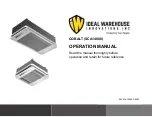
E-mail: [email protected]
Made in Rome, New York, USA
4
EMI AMERICASERIES CONDENSING UNIT - COMMON SECTION
REFRIGERANT PIPING
The standard system will support refrigerant runs to the inside
unit of
100' equivalent feet with a 35' rise included.
Units are furnished with sweat connections and are equipped
with service valves and schrader fittings for charging and taking
pressure readings. The following precautions should be made:
• Be certain no burrs remain on the fittings.
• Use only clean refrigeration tubing.
• Use tube benders to guard against kinking.
• Avoid piping on wet and rainy days and insulate suction line.
Be certain that plastic end caps remain in place when insert-
ing through wall openings. Isolate tubing from transmitting
vibration to the building or unit and avoid contact with sharp
edges.
Refrigeration valves should be wrapped with a wet
rag "heat sink" to protect valves while brazing.
NOTE:
It is recommended that a filter dryer be installed in
liquid line, at the air handler.
P-TRAP INSTALLATION
• A P-trap is recommended when the suction riser is equal to
or greater than 20 feet in height
.
• When the evaporator is installed above the compressor, the
P-trap will prevent the flow of liquid back to the compressor
in the off cycle.
• The placement of the P-trap should be at the halfway mark
of the suction riser. For example if the suction riser is 30 feet
tall then a P-trap is recommended at the 15 foot mark of the
suction riser
(see Figure 1).
• A P-trap may be fabricated using (2) street elbows and (1)
regular elbow. A prefabricated trap may be purchased from a
Wholesaler or Distributor however the trap should be shallow
as the (3) elbow configuration. Each elbow is approximately
5 equivalent feet. One P-trap is equal to approximately 15
equivalent feet.
• Whether the outdoor unit is above or below the indoor unit
a P-trap is recommended if the suction riser is 20 feet or
higher.
NOTE:
Avoid excessive oil buildup. The P-trap should have
a shallow depth and a short horizontal section.
• P-traps are not required at the foot of the hot gas risers due
to increased oil flow at higher temperatures.
REFRIGERANT PROCESSING
WARNING!! It is illegal to discharge refrigerant into the
atmosphere after July 1, 1992. Use proper reclaiming
methods & equipment when installing or servicing this
unit.
The unit is delivered with precharged refrigerant for the condenser
coil and the evaporator. Charging of the field installed piping is
required. Refer to the refrigerant charge table for the proper
amount to be added for the applications interconnect pipping.
Unit service valves are solid brass.
IMPORTANT:
All systems require field charge adjustments.
Refer to the attached "Charge Adjustment Table" for proper
weight charge and to the supplied "Operational Charts" for
proper system pressures and temperature at different outdoor
conditions. Superheat and subcooling method should be used
for final system charge (see page 6).
When charging and checking pressures/temperatures on
system supplied with Low Ambient Option, the fan cycle
switch should be jumped out of the circuit temporarily to
obtain accurate data.
COMPLETE PIPING CONNECTIONS
Pressure test all field installed piping with nitrogen. Using a suit-
able vacuum pump, evacuate the tubing and indoor unit to 300
microns, with service values remaining front seated (closed).
Before releasing the refrigerant from the condenser, be sure the
manifold gauge set is closed so as not to lose vacuum when
shutting down the pump.
Release refrigerant from the condensing unit by back seating
the service value. Allen wrenches are used to open the valve.
Replace valve caps. Be Careful to not back seat the valves past
the snap flanges that hold the valve core in place.
Figure 1


































